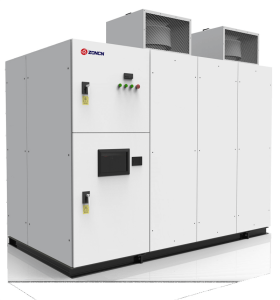
High-voltage inverters are usually used in the industrial field and are suitable for high-power, high-voltage (usually over 1kV) applications. They can provide higher output power and carrying capacity, and are suitable for driving large motors, generator sets and other high-power equipment. The circuit design and control system of high-voltage inverters are usually more complex to cope with the requirements of high voltage and high current.
Low-voltage inverters are suitable for low-voltage (usually below 1kV) applications and are widely used in household appliances, small mechanical equipment, air conditioners, etc. They usually provide lower output power and are suitable for speed regulation and control of low-power equipment. Low-voltage inverters are smaller, cheaper, and easier to operate and maintain than high-voltage inverters.
In summary, high-voltage inverters are mainly used for high-power applications in the industrial field, while low-voltage inverters are suitable for low-power applications in homes and small equipment. There are obvious differences in their voltage range, power level and applicable scenarios.
High-voltage inverters and low-voltage inverters are two different inverter devices, and their main difference lies in their applicable voltage range and power level:
Working voltage range:
High-voltage inverter: High-voltage inverters are usually used in power systems. Their input voltage range is generally between several thousand volts (kV) and tens of kilovolts (kV), and the output voltage range is relatively high. High-voltage inverters are usually used in large industrial drive systems, power grid transmission and distribution systems, and other fields.
Low-voltage inverter: Low-voltage inverters are suitable for low-voltage equipment and power systems in industrial and commercial fields. Their input voltage range is usually between hundreds of volts (V) and thousands of volts (V), and the output voltage is also relatively low. Low-voltage inverters are often used in applications such as motor control, HVAC systems, and water pump systems.
Technical features and design requirements:
High-voltage inverter: Since high-voltage inverters need to handle higher voltages and powers, their design and manufacturing technology requirements are higher, including insulation, cooling, selection of switching devices and heat dissipation. Low-voltage inverter: Compared with high-voltage inverters, low-voltage inverters are usually easier to install, maintain and operate, and their design and manufacturing costs are relatively low.
Despite these differences between high-voltage inverters and low-voltage inverters, they are also connected and interactive. In some application scenarios, it may be necessary to connect and cooperate high-voltage and low-voltage systems, and use high-voltage inverters and low-voltage inverters to work in coordination to meet the needs of the entire system.
In addition, both high-voltage inverters and low-voltage inverters belong to inverter technology, and their basic principles and functions are similar, and both can achieve functions such as motor speed regulation, energy saving and control.

